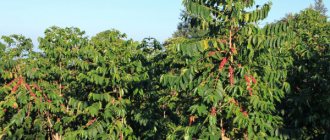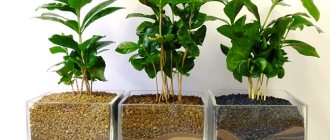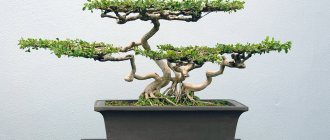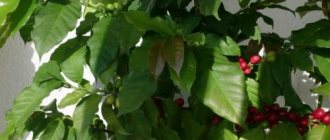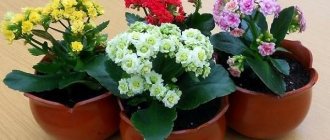Indoor trees are very popular in modern decorative floristry. Compared to regular flowers, they require significantly less care. At the same time, a small tree looks impressive in almost any room.
Dear readers! For you, we have created communities on social networks in which useful articles and interesting ideas are published several times a day! Subscribe and receive useful content in a convenient format!
In today's article we will talk about one of the most popular indoor woody plants, the coffee tree.
Botanical description and homeland of the plant
The plant is part of the Rubiaceae family. The tree's homeland is ancient Abyssinia (modern Ethiopia). Now the coffee tree can be found even in the wild in South America, Asia, and other areas of Africa.
Indoor varieties are widespread everywhere.
At home, coffee is a low bushy tree that grows mainly in several thin trunks. The plant does not branch much. The process of formation of additional shoots usually begins only in the 2nd year. Coffee has large oval leaves with a pointed tip. The surface of the leaf blade is slightly convex with clearly visible veins. The color is green.
Coffee blossoms and bears fruit. The inflorescence is umbellate and consists of small white flowers. After flowering, a fruit is formed, which turns red when ripe. The berry is covered with a small crust, inside there is sweet and sour pulp and a couple of seeds-grains, from which the famous drink is prepared.
Types of coffee trees
Below we will describe those varieties of coffee trees that are most popular in indoor cultivation.
Arabian coffee tree (Coffea Arabica)
This variety is popularly known as Arabica. In the wild, the bush reaches six meters in height. In indoor culture, its dwarf variety “Nana” is grown, the height of the bush does not exceed 0.8 m. Flowering is observed twice a year. The bush can be easily shaped.
Congolese coffee tree, or Robusta (Coffea canephora)
The variety is unpretentious and has a well-developed root system. A characteristic feature of this variety: after the fruit branches die naturally, they fly away.
Liberian coffee tree (Coffea liberica)
This tall and fairly large shrub has a pyramidal-shaped crown. It can be grown both in a spacious room and in a greenhouse. The variety is highly resistant to most diseases of coffee trees.
Caring for your coffee tree after purchase
Before you go to the store and buy yourself a new green pet, you should think about where to put it. Remember that coffee is a tree, and although it will not grow to several meters at home, it still needs space.
So, you bought yourself a coffee seedling. First of all, he must be quarantined. This is necessary so that the plant gets used to the new conditions. Also during this time you can find out whether the plant is sick and whether pests live on it.
In addition to quarantine, the coffee tree can be replanted. A transplant is required in the following cases:
- Several coffee cuttings sit in one container;
- The pot is too low quality;
- The soil mixture is a nutrient substrate, not ordinary soil.
ON A NOTE. Don't worry if all the leaves have fallen off the tree after replanting. This is due to the fact that all the plants in stores are “overfed”. Very soon the coffee will return to normal.
Features of seeds
A ripe berry consists of pulp and two grains, suitable for planting in the soil. The coffee plant is very demanding of the environment. Common varieties used for planting:
- Maragogyp;
- Abbisinka;
- Bourbon;
- Mundo novo.
Maragodzhip has a distinctive feature. Among all varieties of coffee, its grains are “giant” in size. Suitable for planting in any soil. The peculiarity of the variety is that it acquires a different aroma and taste when grown in different (composition) soil.
For all varieties, there is a certain natural condition - only plants grown at an altitude of 1-2 kilometers above sea level bear fruit.
Growing conditions
In general, the coffee tree does not pose impossible tasks for the grower. The plant needs quite ordinary care and growing conditions, but with its own characteristics.
Temperature
Coffee loves warmth, but does not handle heat very well. The ideal temperature is 23 – 25 degrees. In winter, you can slightly reduce the temperature, but only to 15 degrees. If the temperature drops further, the coffee may shed its leaves.
IMPORTANT! Protect the tree from sudden changes in ambient temperature and drafts. Both have a negative effect on flowering and fruiting.
Air humidity
Coffee prefers high air humidity. In a dry climate, the tree does not feel well, often gets sick, and blooms poorly.
Additionally, it is recommended to spray the plant with a spray bottle. In the summer, you can periodically “bathe” the coffee tree.
IMPORTANT! In winter, the tree tub should be placed away from radiators, as the tips of the leaves will begin to wither due to dry air.
Coffee also loves fresh air, so we recommend periodic ventilation in winter. The main thing is to make sure that there is no draft, as this can make the plant sick.
Coffee tree after spraying
Lighting
The coffee tree comes from Africa, which means it loves light. But it is still undesirable to expose it to direct sunlight. It would be ideal to shade the plant a little. To do this, you can cover the windows with paper, use tulle or Roman blinds.
ON A NOTE. If your apartment does not have the right place with sufficient lighting, then the coffee tree can be placed under fluorescent lamps.
The soil
For a coffee tree, it is better to choose acidic soil (with a pH level less than 7). If you prepare the soil yourself, then follow these proportions: 2 parts acidic peat, 1 part distilled, 1 part sand, 1 part each leaf and greenhouse soil.
Pot
It is equally important to choose the right pot. In a container that is too small, the plant will be cramped. The roots will quickly fill the entire volume, and the coffee will begin to hurt. If it is too large, on the contrary, the tree will not be able to receive all the nutrients when watering and feeding.
It follows from this that you need to choose a medium-sized pot for the plant, so that it is not cramped, but there is space to grow.
In what cases is support needed?
Sometimes your green pet may need support. These are mainly cases when the plant has too thin shoots, as well as after transplanting into a new pot, when the tree has not yet taken root.
Choosing a place to put it
Indoors, the coffee tree is best placed near a south window. If this is not possible, then place the tree on the east or west window.
It is not recommended to place the pot in dark corners or in the back of the room. Lack of lighting negatively affects the decorative qualities of the plant.
In late spring and summer, the coffee tub can be moved to the loggia or taken out to the terrace. The tree will really like this, as it will be provided with a sufficient amount of light and fresh air.
What does it look like in the interior?
The coffee tree is not just another flower in a pot. This is part of the interior decor of any room. The plant looks beautiful in a modern studio apartment, office, and bedroom. The coffee tree is also great for decorating public spaces: cafes, reception areas, corridors, conservatories, etc.
The soil
The coffee tree likes acidic soil (pH in the range of 5–5.5). Acidity can be measured using litmus paper.
To obtain such a substrate, mix:
- 1 part peat;
- 2 parts river sand;
- 2 parts leaf soil;
- 4 parts manure humus;
- 4 parts of turf land;
- some finely chopped sphagnum moss.
Of the store-bought soil mixtures, the substrate for citrus fruits is ideal for a coffee tree.
Flowering conditions
The coffee tree blooms in spring. It forms umbrella-shaped inflorescences consisting of small white flowers. At the same time, the tree emits a pleasant aroma.
REFERENCE. The coffee tree fades very quickly. Don't miss this amazing moment!
Flowering
You can also help the plant bloom. To do this, gently shake the branches on which the inflorescences appeared. Another way is to take a cotton swab or soft brush and touch the flowers. This will cause artificial pollination.
After flowering, fruits begin to set. They ripen almost throughout the spring-summer period, and in some cases the process can even take 1.5 – 2 years.
IMPORTANT! In order for coffee to bloom bright and memorable, it needs to be allowed to rest in winter. During the dormant period, you will have to reduce watering and eliminate the application of fertilizers. You also need to slightly reduce the temperature.
Pruning and crown formation
Seedlings of coffee trees are suitable for growing in standard form. Seedlings obtained from cuttings, over time, if you do not form a standard, turn into a dense bush of a spherical shape.
Arabica coffee tree blooming
In the first year, the shoot grows straight upward; there is no need to pinch it. The tree begins to branch in the second year. If you want to form a trunk with a thick crown, you can make a constriction:
- the operation is carried out in late February - early March;
- when the central trunk grows to 25–30 cm, it is tied tightly with reinforced wire at a height of 15–20 cm, 1 cm below the internode;
- pinch the upper bud; if necessary, trim the shoot so that 2 internodes remain above the wire;
- subsequently, all branches above the constriction that grow upward are cut off. The remaining branches are trimmed to your liking to make the tree look aesthetically pleasing;
- after 3–4 years the constriction is loosened, and after a month it is removed. As a result, with a tree height of 50 cm, the crown diameter can reach 1.5 m.
Transfer
While the coffee tree is young, it is replanted every year. Upon reaching the age of three, the growth of the tree slows down. Accordingly, the frequency of transfers is reduced. It will need to be carried out approximately once every four years.
Replanting a plant is no different from a similar process carried out with other indoor flowers. On the contrary, replanting a coffee tree is even easier, since it has stronger roots.
Saplings
ON A NOTE! But this does not mean that you need to work sloppy. Still, try not to damage the root system.
- First of all, prepare a pot of suitable size, proper soil and drainage.
- First, place the drainage in a new container.
- Then remove the plant from the old pot. This must be done using the transshipment method.
- If old drainage is stuck to the bottom, carefully shake it off.
- Carefully remove the old soil.
- If you want to plant the cuttings in different pots, then place the entire plant in a bowl of warm water and carefully wash off the remaining soil. Next, carefully separate the tangled roots of each stem.
- Sprinkle the drainage in the new pot with soil and place the seedling there.
- Carefully add soil to the desired level and water the transplanted plant.
IMPORTANT! If you are not replanting, then change the top layer of soil. This is necessary so that the earth does not become depleted.
Reproduction
Coffee is propagated by seeds or vegetatively. Below we will talk about each method in a little more detail.
Propagating a coffee tree from seeds
If you are an experienced gardener, you can try to grow a coffee tree from an ordinary coffee bean.
Fruit
REFERENCE. Roasted grains will not work.
First of all, it is necessary to destroy the “shell” on the grain. To do this, you can carefully file it or soak it in a solution of hydrochloric acid. We recommend making careful cuts, as the use of chemicals can damage the seed itself.
Next, the seeds are washed with potassium permanganate and placed in a solution of a growth stimulator. Any will do.
You need loose soil, consisting of turf soil, sand, ash and peat. The seeds are placed in the soil and pressed down slightly. Then the plantings are watered and covered with film, a transparent plastic lid or a plastic bag. This is how we create a greenhouse effect inside.
There is no need to place the pot directly in the sun, but it should not be placed in the shade either. A warm place near the windowsill is best.
The seeds will germinate in about a month.
The first transplant is carried out when foliage appears.
How to propagate vegetatively
The vegetative method is the most effective and requires much less labor.
- First of all, prepare the cuttings. They should be about 8 – 10 cm long and have at least 2 buds.
- Then place the cuttings in containers and keep them warm.
- To make rooting go better, put a plastic bag on top or cover it with a jar. This will create a greenhouse effect.
- Periodically water the soil and ventilate the seedlings.
- Once the plants have taken root, they should be transplanted into permanent pots.
Propagation by cuttings
Growing from grains and cuttings - what are the features
To grow a tree at home from grain, you need to buy recently picked berries that are fully ripe. Shelf life is one and a half months after collection. Germination gradually deteriorates over the course of a month. 2 weeks after harvest , the guarantee that the grain will germinate is 50%. It is recommended to order several beans at once. One of them should sprout.
How to choose seeds:
- It is desirable that they be in pulp.
- The flesh should be burgundy or purple. This means the berries are fully ripe. The green shell will simply rot in the ground.
Next, the soft shell is removed, and the grains are soaked in warm water. After soaking, remove the parchment film to increase the likelihood of germination.
Then soaked in aloe juice or growth stimulant. This need not be done if the seed is fresh.
The grains are placed in prepared moist soil, flat side down, to a depth of 1–1.5 cm, sprinkled with water on top and covered with film.
The pot should be in a warm place. The film is removed daily for 20 - 30 minutes to ventilate, then covered again. It will take 1.5 - 2 months before sprouts appear. They are kept in greenhouse conditions until the second pair of true leaves appears.
Important! You cannot remove the cotyledons from the first leaves that appear, as they can be damaged and the plant will not be able to develop further. It is necessary to increase the level of humidity and the sprout itself will be able to shed its cotyledons
It will take more time to grow Arabica from grain, but the plant will be well adapted to the apartment climate, unlike purchased plants. The disadvantage of this method is that the tree must be grafted with cuttings to bear fruit. It will bloom, but few berries will form.
Growing from cuttings guarantees that with good care the tree will bear fruit, and the varietal characteristics are also preserved. Such a tree begins to bloom during the process of rooting. A coffee tree cutting is selected from the middle part of the plant. It’s good if these are last year’s branches, since they already have buds and such a specimen will take root faster.
Before planting, heteroauxin is used, immersing one end 1 cm in the solution. Indolylbutyric acid will also help to take root - 25 mg per half liter of water - soak for 16 hours.
Planting is done in a specially prepared mixture. You can use perlite and bog sphagnum moss. Do not compact the soil too much to ensure air access to the roots. Pour in a weak solution of potassium permanganate. The petioles of the lower leaves should fall into the soil, since this is where roots are most likely to form.
How to form a crown
The coffee tree itself is highly decorative. Its shoots are weakly branched, and large beautiful leaves form a beautiful crown. In general, coffee does not require decorative pruning.
However, it all depends on the specific instance. It is necessary to regularly trim dried shoots, and it is also a good idea to remove too long branches. The fact is that they will take away the energy that the plant needs to bloom. It is better to carry out the operation in late winter - early spring.
If you doubt whether your green pet needs pruning, then it is better not to do it.
Rejuvenation
Unfortunately, about 10 years after planting, coffee begins to age. The decorative value of the plant decreases. The leaves become yellowish and limp. So, it's time to rejuvenate.
To do this, cut the stems. The procedure must be carried out with a sharp instrument so that the cuts are neat and even. Do not break the shoots under any circumstances! Even if the tree survives, it will finally lose its decorative effect and become ugly.
Don't forget to treat the cut areas with crushed activated carbon.
ON A NOTE. By the way, cuttings are taken from the cut branches for propagation.
Watering
Coffee is a water-drinker. In the spring-summer period, you need to water abundantly and often (every 2 - 3 days). But do not allow the soil in the pot to become waterlogged. Loosen the soil regularly to prevent it from clogging.
During the dormant period, watering should be reduced to once a week. In winter, simply do not allow the soil to dry out and maintain the general level of humidity.
For irrigation you need to use soft, settled water. If you have such an opportunity, water with rain or snow water. But do not forget that the liquid should be at least room temperature, and preferably a couple of degrees warmer. Cold water can cause shock to the roots, which can lead to all sorts of troubles.
Top dressing
The coffee tree blooms and bears fruit intensively, so it needs increased nutrition. It is best to buy a complex fertilizer. The universal organic fertilizer “Miracle of Fertility Sapropel” is well suited for feeding the coffee tree, as well as fertilizers for indoor flowers based on chicken droppings. During the flowering period, the tree can be watered 1-2 times with water infused with straw ash: it is rich in potassium.
Feeding schedule:
- from March to October – once every 2 weeks;
- from November to February – once a month.
If the leaves become dull, wipe them with water and lemon juice (2-3 teaspoons of juice per 1 liter of water). Water the plant with the remainder of the solution (but not more than once a month).
Popular varieties
Coffee is not the most numerous genus of plants. There are only a few dozen species. The following plant varieties are most often grown indoors.
Arabica (Arabian coffee)
It is a low tree with oval leaves. The leaf blades have an olive tint. The flowers are very small. The fruits are burgundy.
Arabica is the most popular variety of coffee to grow indoors.
Nana (Dwarf coffee)
A very beautiful small tree (up to 80 cm) with glossy leaves. Unlike other varieties of coffee, it bears fruit very well in an apartment. Has high decorative value. Loves being sprayed.
Liberian coffee
A tree with a thin trunk and large (30-40 cm) leaves. Unlike other varieties, Liberian coffee has leaf plates that are more rounded towards the end. Fruits abundantly. The berries are yellowish-red. It lends itself well to pruning and crown shaping.
Scientific name
The coffee tree may be called simply Coffee for short. This plant species belongs to the Madder family. There are more than 70 different types of coffee. The most famous types:
- Arabian, also called Arabica;
- Bengal;
- Robusta, or Congolese;
- Cameroonian;
- Liberian.
The following tree-like indoor plants are also grown at home: Ficus “Eden”, “Black Prince”, “Bengal”, “Kinki”, Cypress “Goldcrest Wilma”, Avocado, Lemons “Panderosa”, “Pavlovsky”, some types of ornamental conifers and others . Many of them are suitable for creating bonsai.
Diseases and pests
The most dangerous pests for coffee are:
- Spider mite. If an insect is detected, the plant must be immediately treated with Aktara or Karbofos.
- Shield. To get rid of this pest, the plant is first treated with soapy water and then with insecticides (for example, Karbofos).
- Aphid. They fight it in the same way as with scale insects. This pest can still be removed using regular alcohol. Dampen a cotton pad and wipe the infected leaves and shoots with it.
The most common diseases are Coffee Rust, Gommosis and Sooty Fungus . Diseases manifest themselves in different ways, but most often the leaves are affected. They become covered with brown spots and streaks, or have a black edge.
For fungal diseases, it is better to immediately use fungicides. The fungus is usually very tenacious, and traditional methods may not help. Fitosporin and copper sulfate are effective. It is also necessary to remove the affected parts of the plants to prevent the spread of the disease.
IMPORTANT! Regular preventive inspection of the plant will protect it from 99% of diseases and pests. It is always much easier to prevent a disease than to try to cure it.
How to resuscitate?
If your coffee tree is sick, you can try to save it. Depending on the condition of the plant, there are two effective methods:
- Transfer;
- Rooting cuttings.
If you have “flooded” a flower, you can save it by replanting it in a new pot. To do this, be sure to clean the roots from the old soil, treat them with potassium permanganate, sprinkle with activated carbon and carry out the procedure itself.
Please note that old soil cannot be used.
If the transplant does not help and the plant continues to wither, then the only chance is to cut healthy cuttings and root them. Alas, the old plant cannot be saved.
Common mistakes
The most common mistakes in plant care are, of course, overwatering or underwatering, as well as failure to comply with air humidity requirements. Accordingly, the tree will either begin to rot or will wither and dry out.
It is also worth remembering that in winter the temperature should not fall below 15 degrees. Coffee is a tropical plant that does not tolerate cold weather well. At this time, it is worth reducing watering and stopping the application of fertilizers.
The third most common mistake when growing this plant is using the wrong soil. Of course, an unsuitable soil mixture will not cause the death of the flower, but the decorative effect will decrease. For example, the leaves will turn pale.
Selecting a soil mixture
The species of the coffee tree determines the quality of the grain drink and the possibility of growing in an artificial environment. Not all of the many varieties of coffee are suitable for indoor use.
Coffee beans are harvested from the following types of trees:
- Arabian;
- Congolese;
- Liberian;
- Excellz.
Arabica coffee is of greatest interest. The less demanding Robusta has a high yield, but is inferior to the noble Arabica in terms of taste and aroma. Rich in subtle aromas, the drink made from Arabica beans has a mild taste without excessive bitterness. Rare types of liberica and excelsa are inferior in taste to Arabian coffee and are more often found in blends.
The Arabica coffee plant is quite rare at home, but interest in this evergreen coffee bush or tree continues to persist. In a house, the crop can grow up to a meter in height - this is important to remember when choosing a planting site.
The coffee tree has long shoots and strong branches. There are many of them on the plant, they all form a beautiful lush crown. The rhizomes are unbranched, so the plant can develop freely and quickly when planted in a pot. The leaves on the crop grow oppositely. Coffee leaves are dark green and glossy, oval in shape, pointed at the end, and have obvious veins at the edges.
Fragrant, self-pollinating coffee flowers are star-shaped, white in color and form inflorescences of five. They grow in the spring in the fourth year after the plant is planted in the ground. After just six months, the plant begins to ripen fruits—coffee beans. During flowering, the plant must not be sprayed.
With proper care, you can grow a real coffee tree at home, and also get about 500 grams of a rich and pleasant drink from it in the form of small Arabica beans. With long development, the grains begin to change their color to dark red. Each fruit contains several grains.
Arabica coffee (plant mix) has a large number of varieties widely used in cultivation:
- Abyssinian;
- Bourbon;
- Mundo novo;
- Maragojil (this coffee contains a small amount of seeds, but they are large in size).
Depending on the phase of crop development, experts identify special soil compositions:
A soil mixture that is used for planting coffee sprouts and seeds. To create a substrate, leaf soil and river sand are taken, with the help of which moisture begins to quickly be absorbed into the soil mixture. Before planting a plant, it is important to sterilize the soil. The procedure is carried out by placing the seeds in a water bath, where they are left for five minutes.
When planting, the seeds are placed flat on the ground. If all the rules have been followed, then after a month and a half, seedlings will begin to appear. After waiting for the first leaves to appear on the crop, it is important to think about transplanting the young shoots into better soil, which will ensure their growth and formation. But you need to remember that transplants will have to be carried out annually until the crop is three years old. In the future, the frequency of transplants will be reduced to once every few years.
Soil that is prepared for planting an adult flower. It is created on the basis of sand, acidic peat, leaf soil, humus, moss and charcoal - all this is taken in equal proportions. In order not to search for too long for all the listed components of the substrate, they can be purchased at a special store. If a gardener wants to get an adult tree as quickly as possible, then it is best to transplant the seedling into a larger pot. Then the rhizomes will grow deeper, and the crop will receive the required amount of microelements and nutrients from the soil.
Planting a plant using the vegetative method includes preliminary preparation of a cut cutting. To do this, it is placed in a special product for several hours. It is allowed to begin planting after all the necessary material is ready. Next, the plant begins to be transplanted into the soil, into which it is deepened no deeper than three centimeters.
Answers to popular questions
Why are my tree's leaves drying out?
This occurs due to too dry air in the room. Place saucers of water next to the pot or use an automatic humidifier. You can also put wet pebbles or other pebbles, moss, etc. in the tray.
What to do if pests appear?
First of all, the plant needs to be isolated from other flowers. Then treat with insecticides. Take your time to return the pot to its place. It is likely that you will have to process it several times.
The leaves are very pale and inconspicuous. What's happened?
As mentioned earlier, coffee loves acidic soil. Loss of decorative qualities of foliage is one of the indicators that the soil mixture is not suitable. A transplant is needed.
There are dark spots on the leaves and they fall off. What to do?
There are two reasons for this phenomenon: insufficient watering or insufficient lighting. Check the conditions of the flower. If necessary, move it and feed it.
Possible problems
If there are violations in the care of the coffee tree, problems may arise such as:
- Darkening and drying of the edges of leaf plates . The air in the room is excessively dry.
- The foliage turns yellow . The root system has rotted.
- Brown spots form on the leaf blades . Nitrogen deficiency in the substrate.
- The appearance of holes on the leaves . This occurs as a result of sunburn.
- Young foliage turns yellow, while the veins are colored green . The substrate is not acidic enough.
- The foliage turns yellow, begins to rot and flies off . Moisture regularly stagnates in the soil mixture.
- Flying leaves in winter . The shrub feels an acute lack of light.
- Excessively slow growth . Lack of nutrients in the soil mixture.
- The foliage becomes wrinkled and yellow spots form . Potassium deficiency or soil mixture is moistened with hard water.
- The leaf blades are covered with brown or purple spots . The phosphorus content in the substrate is too low.
- Young foliage is pale yellow and very small . This is how iron deficiency manifests itself.
- The most common pests that inhabit the plant are mealybugs, scale insects and spider mites.
Interesting Facts
In addition to aesthetic benefits, coffee also brings practical benefits. The tree acts as a kind of filter, cleansing the room of impurities and toxins.
There are also repeated reviews that the coffee tree has a sedative effect, calms the nerves, removes stress and fills a person with new strength.
If you want to make coffee from home-grown coffee beans, keep in mind that the drink will be much stronger than store-bought coffee. This is due to the fact that homemade coffee has a higher concentration of caffeine.
In the teachings of Feng Shui, it is believed that the presence of a coffee tree in a house helps to increase the wealth of its inhabitants.
Esotericists advise placing a tree in the bedroom, as they believe that it strengthens mutual feelings.
Coffee bush pests
Plants that are not properly cared for are affected by pests and, as a result, get sick. If the leaves turn yellow, sticky discharge and spots appear on them, it is affected by scale insects. Wipe the leaves with tobacco infusion or soapy water.
The spider mite settles on the back side of the leaf and sucks out the juice. The leaves turn yellow and fall off. Spider mites appear at high temperatures and low air humidity. The infected plant is treated with insecticidal soap.
Soap is made at home. To do this, take: 1 liter of water, 1 tablespoon of dishwashing detergent, 2 drops of iodine. The resulting solution is sprayed onto both the plant and the soil underneath it. As a preventive measure, the flower is washed alternately very quickly with cold and hot water. The soil is covered with cellophane during the procedure.
Remember these 4 “ifs” to keep your plant looking healthy.
- if the acidity of the soil is insufficient, the leaves of the bush lose their shine and become discolored
- if it does not receive air flow, the leaves turn yellow and dry out
- if the room humidity is excessive, the leaves will rot
- if the water is hard, rusty spots appear on the sheet.
The life of a coffee tree is not too long - 8 - 10 years. “As it ages,” it loses its decorativeness. It is recommended to cut the crown of the tree at a height of 8-10 cm and form a new coffee tree from the resulting shoots.
